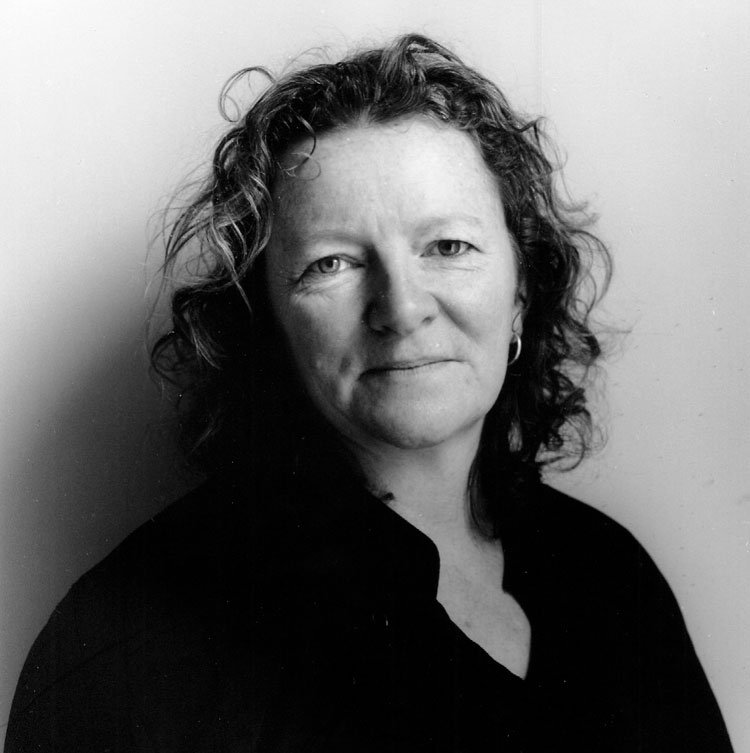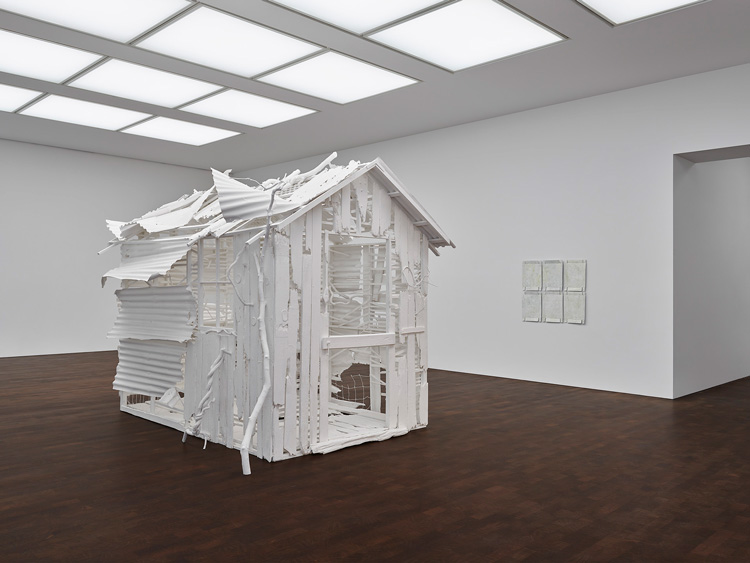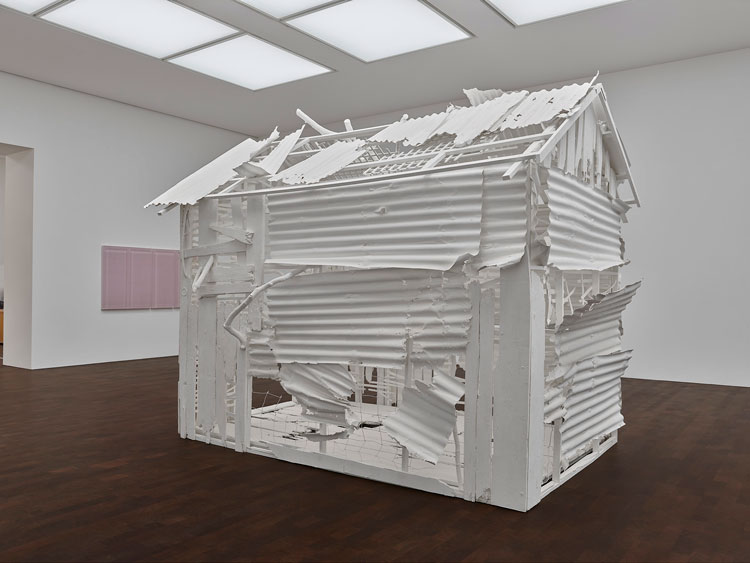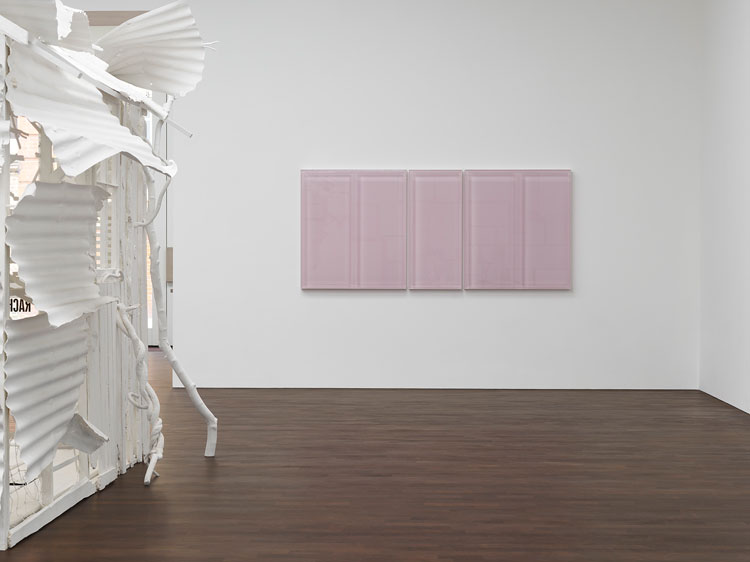

by JULIET RIX
Rachel Whiteread (b1963) has had a productive pandemic and, on the spring day when the UK emerges from its long winter lockdown, she is opening an exhibition at the Gagosian Gallery in the West End of London. The works, suitably distanced across two large rooms, range from current takes on familiar themes to some significant departures from the language of casting for which Whiteread is so well known.
She was born in Essex and brought up in London, her mother an artist, her father a teacher and lecturer, and she discovered casting while on the painting course at Brighton Polytechnic. In a workshop led by the sculptor Richard Wilson, they cast a spoon, the dip of the bowl disappearing, but the overall shape remaining. Whiteread was intrigued, she later said, by how this both lost and retained the object’s essential “spoon-ness”.
[image2]
Moving on to an MA in sculpture at the Slade, Whiteread made her first substantial cast sculpture, Closet, a plaster cast of the interior of a wardrobe, which she covered in black felt. After graduating in 1987, success came quickly, with her first solo show at London’s Carlisle Gallery in 1988 and, by 1990, the casting of Ghost, a whole room in a house in Archway, north London, not unlike (and not far from) the house in which Whiteread grew up. Ghost was bought by Charles Saatchi and included in his first Young British Artists (YBA) exhibition in 1992, alongside work by Damien Hirst and Tracey Emin. Unlike them, Whiteread was never interested in notoriety or commerce, though recognition and making money from her art has certainly been welcome, and allowed her to work with fewer constraints.
Ghost soon led to House, probably still Whiteread’s most famous work. A concrete cast of the whole interior of an about-to-be-demolished house in London’s East End, it was controversial and seminal – and it won Whiteread the 1993 Turner Prize, the first to be awarded to a woman.
Whiteread continued to work with “negative spaces” and began to cast in resin. Untitled (One Hundred Spaces) 1997, saw her solidify the spaces beneath chairs. A year later she cast a water tower and displayed it on a roof in New York, before in 2001, topping the Fourth Plinth in Trafalgar Square with a transparent resin cast of the plinth itself. She cast a concrete library for the Holocaust Memorial in Vienna (2000) and filled the Tate Modern Turbine Hall with white plastic casts of cardboard boxes (Embankment, 2005-6), before completing several “shy sculptures”, site-specific-works in quiet, hidden or remote locations, several of them casts of the interiors of huts or cabins.
A large 25-year Tate retrospective (though she hates the term, she says, for sounding end-of-career) in 2017-18, was shortly followed by a damehood in the 2019 Queen’s birthday honours list. Her career is, of course, far from finished and the new show brings a novel direction, as I found out when I caught up with Whiteread putting the finishing touches to the exhibition at the Gagosian gallery.
Juliet Rix: First, congratulations on getting this to happen mid-pandemic.
Rachel Whiteread: I’m very lucky to have a big studio, and artists are used to working on our own, so it’s actually been quite good to slow down and not have to travel and do all those other things. It’s been a very concentrated period of work for me.
[image4]
JR: Has the pandemic found its way into your work?
RW: Well what do you think (she laughs)?
JR: I think it just might have. Perhaps particularly in Poltergeist and Doppelganger (the two “sheds” or “huts” in this show). The essay by Richard Calvocoressi (director of the Gagosian Gallery) for the catalogue suggests the sheds may have been “violently disrupted” or “torn apart”. I’m not seeing violence so much as an incursion by nature?
RW: I wouldn’t say they’ve been blown apart, but something “other” has been going on, and whether that is from the weather or time or something more spiritual or … I think it’s open-ended really.
JR: Looking at them just now, it seems the natural world is imposing itself, taking back, saying: “No, you humans are not in control.”
RW: Yes, that’s where I’ve been going with it. There are certain elemental things, and having lived through these times with a family … We spent the first part of the lockdown last year in Wales, where we have a house. We’ve been going there for 25 years, but it was very pertinent to be there through a whole season. The house is in the middle of nowhere and to be so away from people, just with this little family unit, felt very different. It didn’t feel like we were survivors, but it did feel removed from what we were all used to.
[image5]
JR: Really quite elemental?
RW: Yes.
JR: Do you see your new work for this exhibition – as others clearly do – as a significant departure?
RW: Yes, in terms of building and creating in a way that I haven’t done before, by using raw materials and unifying the raw materials with paint, rather than unifying the interior with plaster or whatever I am casting with.
JR: But you’ve stayed with monochrome, or something close to monochrome.
RW: A lot of the raw materials were decomposing, so everything was treated and then I wanted to unify it. I tried other colours, but felt that using the white was very pertinent because white is never just white – it reflects the colours that surround it. It felt to me like a way of giving it more energy, energy in its surface.
JR: You have worked with found materials before, haven’t you?
RW: Yes. At Brighton and before. I’ve always picked things up. I’m a magpie. When I was a child we lived out in Essex for a while and we used to go to dumps. They were a sort of postwar thing, I think, clearing things out. You could go and find a whole dinner service. I remember it being incredibly exciting – a treasure hunt. We were a family of magpies, I think. You could also dig at these dumps and I collected Victorian lemonade bottles. It’s a bit like mud-larking but the treasures were larger!
[image3]
I’ve always got a studio full of crap, and I play around with things. This work is an extension of that. It’s about honing something down, really. I spend a long time working with those elements and gradually honing them in. It’s a different process to the casting, to a similar end.
JR: The casts from flattened cardboard boxes, such as Untitled (Pink and Yellow), are more like your earlier castings with their scars and marks and the indentations left from their use?
RW: Yes, absolutely, that’s what draws me to them. Those were cast in bronze at the foundry, then under-painted, then I stripped them back and repainted and worked with them.
JR: A lot of your work is about the marks we leave, life leaves, on the things around us. It is often described as minimalist, but that does not seem quite it to me. More essentialist?
RW: Yes. I think that’s right. There’s certain work that I make that has a clarity to it, it’s poetic, with clean lines – like the resin works – and then there’s other work that has more of a residue, like the bronzes and Doppelganger and Poltergeist. They have a real essence of the world in them. There’s a minimal aspect to my work and people like to put labels on things. People often say: “She makes minimalism with a heart – a sort of female version of minimalism.”
[image8]
JR: How do you feel about that?
RW: I just take it with a pinch of salt. If people need a label, that’s fine. I think the thing that artists do is work with what they know and that becomes a language and you start to add to that language and look for different parts to that language. It’s a way of training your eye and working with the things that you’re interested in, and then you turn it into your language.
JR: A bit like a photographer who is seeing patterns, angles, meaning in what most of us walk straight past?
RW: Yes, I’d say it’s very similar.
JR: Do you think with this new work there is a sense of loosening control, perhaps letting your hair down a little bit?
RW: Yes. I wouldn’t put it quite like that, but it is finding a different way of working, a different experience. When you’re casting sculpture you have to be extremely clear about what you’re doing right from the beginning. You make the mould, you pour the mould, you dismantle the mould and the object appears. With this, it’s a very different process. You have a bit of wood and a bit of metal and a bit of cardboard and bit of this and that, and you’re playing with it in different ways. There’s a flexibility to it, and an invention to it that is different.
[image6]
JR: Richard Calvocoressi’s essay talks about this work being freer and more like an abstract painting. You first trained as a painter. Do you think that makes a difference to your work as a sculptor?
RW: I’m not sure I really trained as a painter. I was at Brighton for three years. The first year I painted, the second year I didn’t really paint and the third year I definitely didn’t paint. It was really just a path I was following. I was frustrated with things being just on the wall. I wanted to draw things down to the floor, to be in the room. I think there’s always been a painterly aspect to what I do though. I’ve always made drawings and the drawings often use paint and different media. I’ve made a lot of prints, too. It’s always been something I’m interested in – the two-dimensional aspect of what I do. It’s often the way I think, and a sort of mindful reaction to doing the other more heavy-duty work of casting and sculpting.
JR: You have long been inspired by painters (as well as sculptors, of course) and I understand you sometimes put pictures of other artists’ work on your studio wall?
RW: I often have works of art on the wall, things I’m kind of referring to at the back of my mind. They’re often historical, sometimes contemporary. There are various artists who have been a big influence over the years, from Bruce Nauman, Louise Bourgeois and Cy Twombly to Piero della Francesca. I had his Baptism up while I was making Ghost. At the moment, I have Géricault’s The Raft of the Medusa, which I’ve been looking at out of the corner of my eye while I’ve been making this work. It’s got the raft, escape, safety, survival – all those things we’re all trying to deal with.
JR: There are quite a lot of nets and fences in this show. Where has that come from?
RW: I’ve always worked with nets, whether it’s lace or fencing. I think it’s the way it’s a sort of lattice work that creates order, but also keeps things in and keeps things out. And it’s a way of making space, but without putting a wall around it, without a barrier.
[image7]
JR: In Poltergeist and Doppelganger, there are a lot of straight lines and lattices of manmade materials as against the more gnarled, uncontrolled, natural shapes taking over. Is that something the pandemic has made you think about on top of everything else?
RW: Yes. But I don’t want to talk about that side of stuff too much. The work is open to interpretation and I don’t want to control how people see it.
JR: Did being in the desert and putting your “shy sculptures” in extreme environments such as the Joshua Tree National Park feed into the making of works like Doppelganger and Poltergeist?
RW: Absolutely, yes. I spent a long time in the desert and have been to different deserts. It’s something that I really love. The loneliness of it, and the way it’s been taken over by the elements.
JR: A landscape that doesn’t need us?
RW: Yes.
JR: Have you drawn away from the “shy sculptures” now, or is it just that it has not been possible to travel?
RW: I definitely haven’t stopped. The shy sculptures are a lifelong project. I’ll be continuing them when the opportunity arises. I am planning on hopefully doing something in Japan next year in a small port town. There’s an interesting little house and I’ll be making a shy sculpture there. They approached me. It’s nice. Gradually people are getting to hear about these pieces and coming to me with ideas. If I can make them happen, I will.
JR: What attracts you to putting sculptures in places where not many people go?
RW: For me, the journey [to visit the work], is as important as the actual thing. I like the idea of the pieces I’ve got out in the desert drawing people there. The guy that I made them with is so proud of them that he regularly takes people to see them. And people don’t even necessarily need to go there. I also like the idea of using memory and photographs and thinking about a place, to transport them there. There’s a piece on a fjord in Norway that hardly anyone will ever see, but I know it’s there, and eventually I’ll make some sort of book. I haven’t felt the need to yet. I think there need to be more of them first.
JR: House now lives on only in memories and photographs. It was such an important work – for you and others. How do you view it looking back?
RW: I’m extremely proud to have made it. I was incredibly privileged as a young artist to be able to make something like that, and I think it really did something to change the debate on public sculpture which I’m very proud of.
JR: And it fed into a lot of what you have done since?
RW: Yes, it’s definitely been a precursor to many things.
JR: Will you continue to cast alongside the new constructing from scratch?
RW: Oh, yes, I’ve just added another string to my bow.
• Rachel Whiteread: Internal Objects is at Gagosian Gallery, 20 Grosvenor Hill, London, 12 April – 6 June 2021.


-juliet-rix.jpg)
-juliet-rix.jpg)
-juliet-rix.jpg)
-juliet-rix.jpg)

